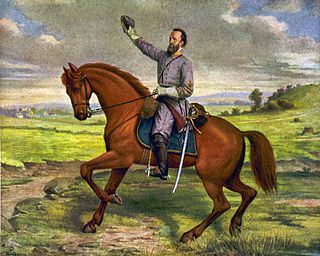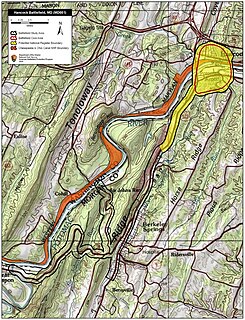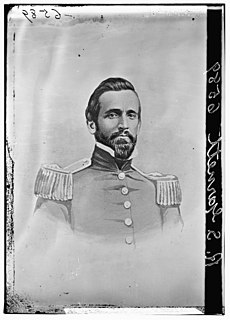
Thomas Jonathan "Stonewall" Jackson served as a Confederate general (1861–1863) during the American Civil War, and became one of the best-known Confederate commanders after General Robert E. Lee. Jackson played a prominent role in nearly all military engagements in the Eastern Theater of the war until his death, and had a key part in winning many significant battles.

The Second Battle of Bull Run or Battle of Second Manassas was fought August 29–30, 1862, in Prince William County, Virginia, as part of the American Civil War. It was the culmination of the Northern Virginia Campaign waged by Confederate Gen. Robert E. Lee's Army of Northern Virginia against Union Maj. Gen. John Pope's Army of Virginia, and a battle of much larger scale and numbers than the First Battle of Bull Run fought on July 21, 1861 on the same ground.

The Army of Northern Virginia was the primary military force of the Confederate States of America in the Eastern Theater of the American Civil War. It was also the primary command structure of the Department of Northern Virginia. It was most often arrayed against the Union Army of the Potomac.

Jackson's Valley campaign, also known as the Shenandoah Valley campaign of 1862, was Confederate Maj. Gen. Thomas J. "Stonewall" Jackson's spring 1862 campaign through the Shenandoah Valley in Virginia during the American Civil War. Employing audacity and rapid, unpredictable movements on interior lines, Jackson's 17,000 men marched 646 miles (1,040 km) in 48 days and won several minor battles as they successfully engaged three Union armies, preventing them from reinforcing the Union offensive against Richmond.

Turner Ashby Jr. was a Confederate cavalry commander in the American Civil War.

John Bell Hood was a Confederate general during the American Civil War. Although brave, Hood's impetuosity led to high losses among his troops as he moved up in rank. Bruce Catton wrote that "the decision to replace Johnston with Hood was probably the single largest mistake that either government made during the war". Hood's education at the United States Military Academy led to a career as a junior officer in the infantry and cavalry of the antebellum U.S. Army in California and Texas. At the start of the Civil War, he offered his services to his adopted state of Texas. He achieved his reputation for aggressive leadership as a brigade commander in the army of Robert E. Lee during the Seven Days Battles in 1862, after which he was promoted to division command. He led a division under James Longstreet in the campaigns of 1862–63. At the Battle of Gettysburg, he was severely wounded, rendering his left arm useless for the rest of his life. Transferred with many of Longstreet's troops to the Western Theater, Hood led a massive assault into a gap in the Union line at the Battle of Chickamauga, but was wounded again, requiring the amputation of his right leg.

The Seven Days Battles were a series of seven battles over seven days from June 25 to July 1, 1862, near Richmond, Virginia, during the American Civil War. Confederate General Robert E. Lee drove the invading Union Army of the Potomac, commanded by Maj. Gen. George B. McClellan, away from Richmond and into a retreat down the Virginia Peninsula. The series of battles is sometimes known erroneously as the Seven Days Campaign, but it was actually the culmination of the Peninsula Campaign, not a separate campaign in its own right.

The Battle of Gaines' Mill, sometimes known as the Battle of Chickahominy River, took place on June 27, 1862, in Hanover County, Virginia, as the third of the Seven Days Battles of the American Civil War. Following the inconclusive Battle of Beaver Dam Creek (Mechanicsville) the previous day, Confederate General Robert E. Lee renewed his attacks against the right flank of the Union Army, relatively isolated on the northern side of the Chickahominy River. There, Brig. Gen. Fitz John Porter's V Corps had established a strong defensive line behind Boatswain's Swamp. Lee's force was destined to launch the largest Confederate attack of the war, about 57,000 men in six divisions. Porter's reinforced V Corps held fast for the afternoon as the Confederates attacked in a disjointed manner, first with the division of Maj. Gen. A.P. Hill, then Maj. Gen. Richard S. Ewell, suffering heavy casualties. The arrival of Maj. Gen. Stonewall Jackson's command was delayed, preventing the full concentration of Confederate force before Porter received some reinforcements from the VI Corps.

The Battle of Glendale, also known as the Battle of Frayser's Farm, Frazier's Farm, Nelson's Farm, Charles City Crossroads, New Market Road, or Riddell's Shop, took place on June 30, 1862, in Henrico County, Virginia, on the sixth day of the Seven Days Battles of the American Civil War.

The Battle of Hancock was fought during the Confederate Romney Expedition of the American Civil War on January 5 and 6, 1862, near Hancock, Maryland. Major General Stonewall Jackson of the Confederate States Army, commanding his own Valley District and Brigadier General William W. Loring's force known as the Confederate Army of the Northwest, began moving against Union Army forces in the Shenandoah Valley area on January 1. After light fighting near Bath, Virginia, Jackson's men reached the vicinity of Hancock late on January 4 and briefly fired on the town with artillery. Union Brigadier General Frederick W. Lander refused a Confederate request to surrender on January 5, and that day and the next saw exchanges of artillery fire between the two sides. The Confederates burned a bridge on the Baltimore and Ohio Railroad on January 5, but withdrew on the 7th. Jackson later moved against Romney, Virginia, and occupied the town on January 15 after Union soldiers abandoned it. Romney was ordered abandoned on January 30 by the Confederate States Secretary of War after Loring complained about Jackson's orders.

The First Battle of Kernstown was fought on March 23, 1862, in Frederick County and Winchester, Virginia, the opening battle of Confederate Maj. Gen. Thomas J. "Stonewall" Jackson's campaign through the Shenandoah Valley during the American Civil War.
The Battle of Port Republic was fought on June 9, 1862, in Rockingham County, Virginia, as part of Confederate Army Maj. Gen. Thomas J. "Stonewall" Jackson's campaign through the Shenandoah Valley during the American Civil War. Port Republic was a fierce contest between two equally determined foes and was the most costly battle fought by Jackson's Army of the Valley during its campaign. Together, the battles of Cross Keys and Port Republic were the decisive victories in Jackson's Valley Campaign, forcing the Union armies to retreat and leaving Jackson free to reinforce Gen. Robert E. Lee for the Seven Days Battles outside Richmond, Virginia.

The Manassas Station Operations included the operations known as Bristoe Station, Kettle Run, Bull Run Bridge, or Union Mills. It took place August 25–27, 1862, in Prince William County, Virginia, as part of the Northern Virginia Campaign of the American Civil War.

Richard Heron Anderson was a career U.S. Army officer, fighting with distinction in the Mexican–American War. He also served as a Confederate general during the American Civil War, fighting in the Eastern Theater of the conflict and most notably during the 1864 Battle of Spotsylvania Court House. Anderson was also noted for his humility.

Richard Brooke Garnett was a career United States Army officer and a Confederate general in the American Civil War. He was court-martialed by Stonewall Jackson for his actions in command of the Stonewall Brigade at the First Battle of Kernstown, and killed during Pickett's Charge at the Battle of Gettysburg.

Cadmus Marcellus Wilcox was a career United States Army officer who served in the Mexican–American War and also was a Confederate general during the American Civil War.

Gods and Generals is a 2003 American period war drama film written and directed by Ronald F. Maxwell. It is an adaptation of the 1996 novel of the same name by Jeffrey Shaara and prequel to Maxwell's 1993 film Gettysburg. It stars Stephen Lang as Stonewall Jackson, Jeff Daniels as Lieutenant Colonel Joshua Chamberlain and Robert Duvall as General Robert E. Lee. Most of the film was personally financed by media mogul Ted Turner. The film follows the story of Jackson from the beginning of the American Civil War to his death at the Battle of Chancellorsville.
The Romney Expedition was a military expedition of the Confederate States Army during the early part of the American Civil War. It is named for Romney, West Virginia, which at the time was still in the state of Virginia. The expedition was conducted in this locale from January 1 to January 24, 1862, as part of the preliminary actions of Stonewall Jackson's Valley Campaign. Confederate forces under Major General Thomas J. "Stonewall" Jackson cleared Union forces under Major General Nathaniel Banks and Brigadier General William S. Rosecrans from the lower Shenandoah Valley and surrounding Allegheny ranges, and then successfully severed the Baltimore and Ohio Railroad and the Chesapeake and Ohio Canal.

William Whedbee Kirkland was a brigadier general in the Confederate States Army during the American Civil War. He was the only former US Marine to serve as a Confederate general.
Gilbert Simrall Meem was a Virginia farmer and politician who served in both houses of the Virginia General Assembly, as well as became a brigadier general in the Virginia militia and served along with the Confederate States Army in northwestern Virginia and what became West Virginia during the American Civil War. Meem's men participated in Stonewall Jackson's attacks on the towns of Romney and Bath, later Berkeley Springs, now in West Virginia in early January 1862. After the brigade went into winter quarters in Martinsburg, now West Virginia, Meem resigned his commission on February 1, 1862, then served in the Shenandoah County, Virginia local government during the war and in the Virginia Senate following the war, before moving to Seattle, Washington and becoming its postmaster in the administration of President Grover Cleveland, where he became a prominent citizen before his death.


















